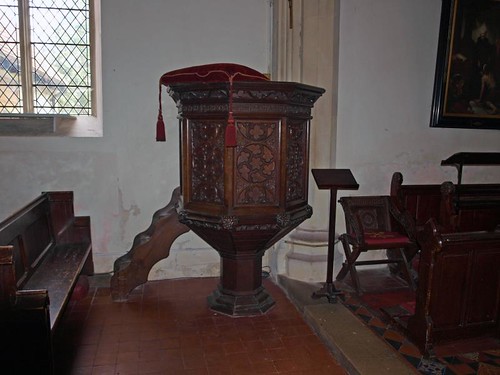ST PETER. The N side of the church shows its C11 origin: one chancel window, the nave E angle and one nave window. Much re-use of Roman brick. C14 S aisle mostly of flint, but also incorporating Roman bricks. C15 W tower with diagonal buttresses and some flint and stone decoration. The S arcade inside is of the C19. - STAINED GLASS. S chapel S and E windows of 1858, typical of their date. - MONUMENT. Tomb-chest with black cover-plate, one brass to a woman and indents of other brasses. The monument was to Thomas Heigham d. 1531.
GOLDHANGER. It stands remote, close to the Blackwater estuary, and down by its sea-wall is a mound of red soil, one of 200 still seen beside the Essex estuaries, sites of potteries in days before history. In this mound Roman pottery was found incarefully constructed flues, and the experts say that here some potters settled in Caesar’s day, working an already ancient site. There is no doubt that the Romans were here, for their bricks are in the church walls, set here by Norman hands. The deeply splayed windows of the Normans have now brilliantly coloured portraits of the saints. The bold tower, the chapel, and the three-bayed roof of the nave are medieval. In the chapel is the altar tomb of Thomas Heigham and his three wives; one of their portraits is still in brass on the tomb, showing her in Tudor costume.
The big churchyard, with its many chestnut trees, is a pleasant place to linger in on an autumn day, when creeper clothes the porch in a glowing mass of red and gold.
The big churchyard, with its many chestnut trees, is a pleasant place to linger in on an autumn day, when creeper clothes the porch in a glowing mass of red and gold.
Simon K -
We left Maldon and headed ever further east, north of the Blackwater,
to the splendidly named Goldhanger, possibly the only village in Essex
named after a James Bond film.
Open. This was the first of several churches built of grey ragstone,
familiar to me from Kent but which I had never come across in this
part of the world before. Presumably there was a quarry nearby. it
isn't a material I particularly like, Not least because it weathers in
such a gloomy fashion, and it is so difficult to date, a Victorian
tower looking as old as a medieval one. Internally, a welcoming yet
typical 19th Century rural restoration. Nothing particularly of note -
a small 15th Century figure brass, a half decent east window. The
church gets a fair number of visitors because the pub next door is a
popular expedition spot from Chelmsford, sitting as it does
overlooking the Blackwater.


No comments:
Post a Comment